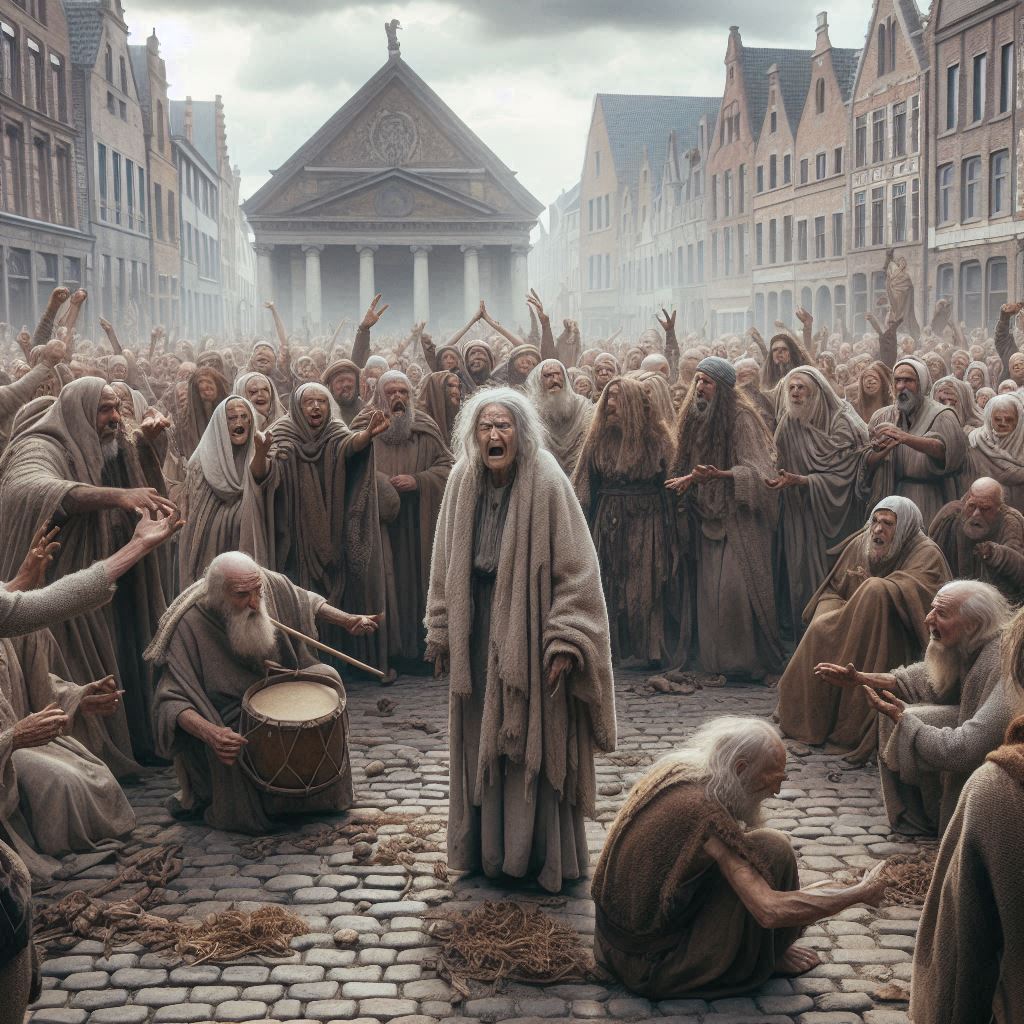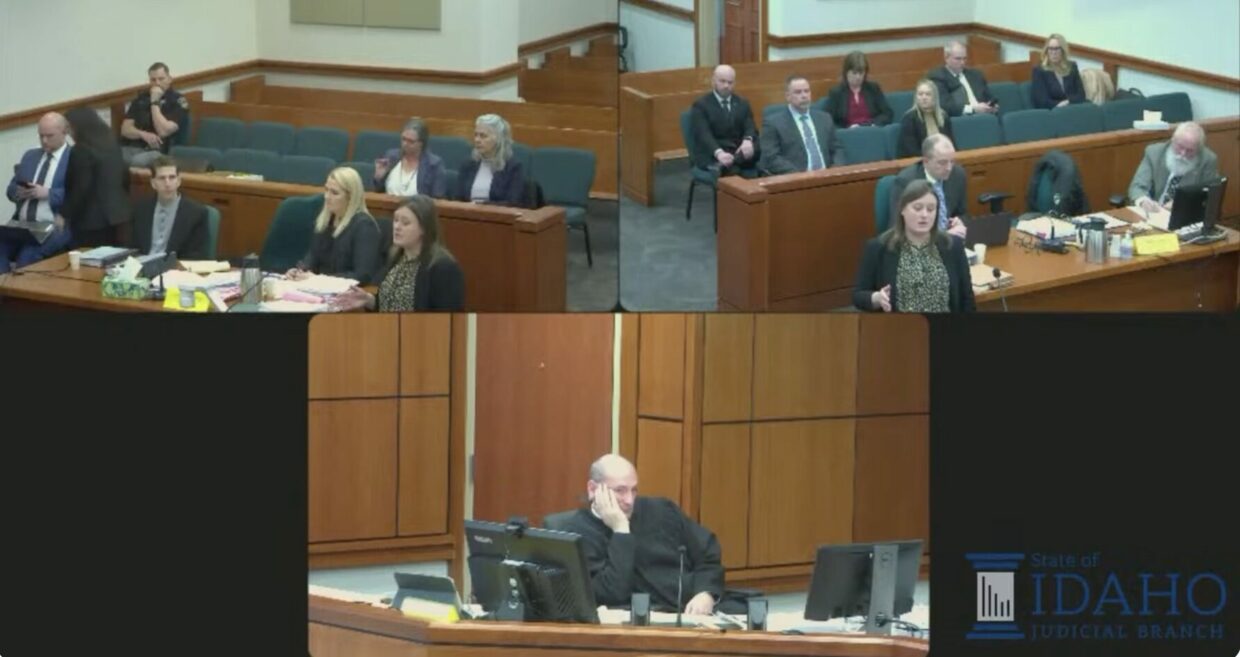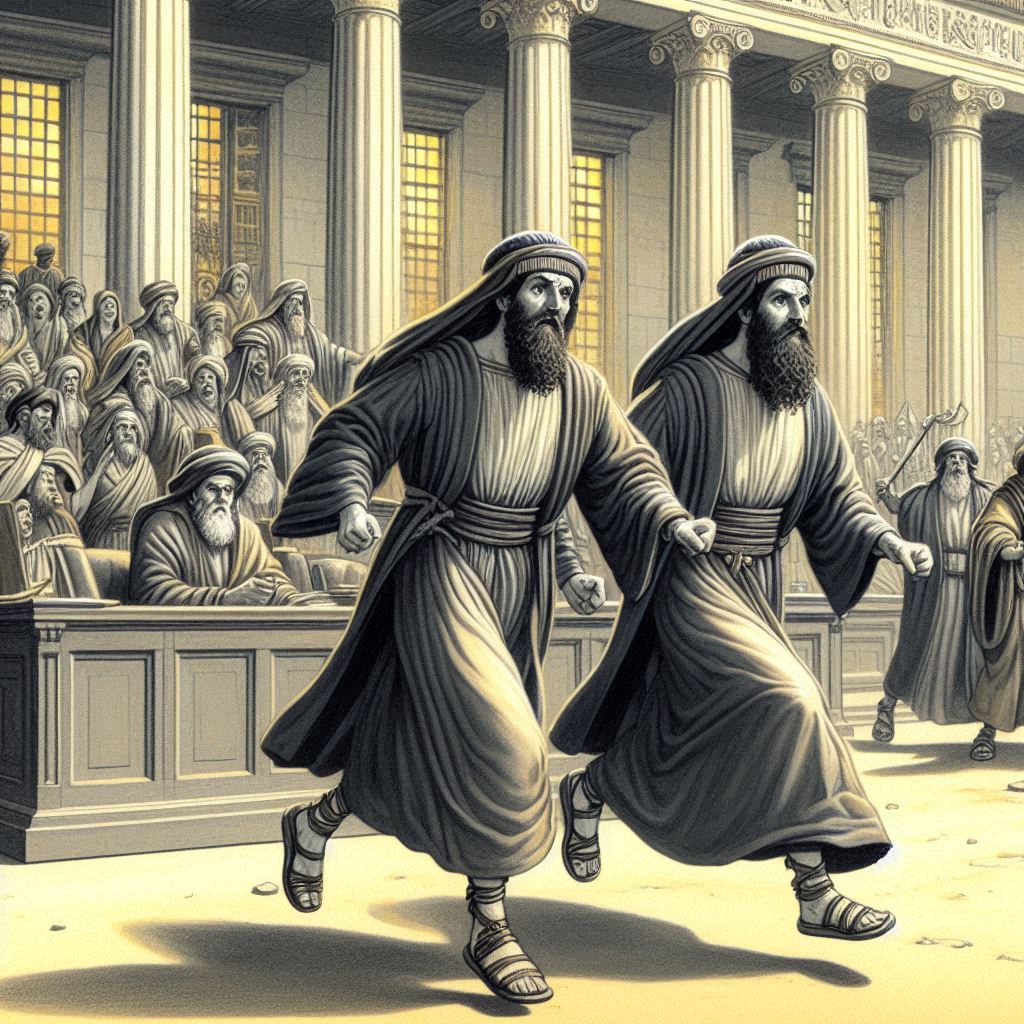Today’s daf continues the conversation about capital punishment via stoning. There are several things of interest, including a blood-curdling description of arguments between Jesus’ disciples and the Sanhedrin regarding their execution (I can see this stuff being used to corroborate the blood libel stuff from Matthew). But there’s also an interesting dispute about finality of postconviction review.
When Herbert Packer wrote The Limits of the Criminal Sanction, the Warren Court was hard at work reforming and federalizing constitutional protections for suspects and defendants by incorporating the Bill of Rights against the states. Witnessing this revolution, Packer contrasted two theoretical models: the Crime Control model, which prioritized efficiency and case management, and the Due Process model, which prioritized quality control and the prevention of mistakes. The latter represented the historical processes that Packer saw unfold during the incorporation process.
One important aspect of the contrast was the changing approach to finality. The Crime Control model operates under the assumption that the police and prosecution probably got it right (Packer calls this “the presumption of guilt”) and thus no corrective postconviction processes will be necessary. The Due Process model, by contrast, aims at providing opportunities to reverse wrongful convictions, opening up appellate and habeas corpus proceedings. Indeed, during the 1960s, the federal habeas corpus writ was widely expanded to accommodate reviews of state criminal convictions. But the post-Warren courts, informed by a Crime Control logic, proceeded to narrow the reach of habeas, by limiting the sort of cases that could be subject to review, the kinds of arguments one could make, and the retroactive application of new rules (here’s a good history of the whole thing.)
The balance between finality and truth is a tough one to strike. On one hand, the collective nightmare of the criminal process is a wrongful conviction, and the worst of the worst is the execution of an innocent person. On the other hand, endlessly dragging the criminal process is torturous to everyone, including the victims, when the delays are just an exploitation of the system. So how do we know when to set the limit?
The first issue that comes up is the question of argument. What happens if one of the Sanhedrin students wants to make an exculpatory argument but cannot?
בְּעָא מִינֵּיהּ רַב אַחָא בַּר הוּנָא מֵרַב שֵׁשֶׁת: אָמַר אֶחָד מִן הַתַּלְמִידִים ״יֵשׁ לִי לְלַמֵּד עָלָיו זְכוּת״, וְנִשְׁתַּתֵּק, מַהוּ? מְנַפַּח רַב שֵׁשֶׁת בִּידֵיהּ. נִשְׁתַּתֵּק? אֲפִילּוּ אֶחָד בְּסוֹף הָעוֹלָם נָמֵי! הָתָם לָא קָאָמַר, הָכָא קָאָמַר. מַאי?
§ Rav Aḥa bar Huna asked Rav Sheshet: If one of the students sitting before the judges said: I can teach a reason to acquit him, and he became mute and cannot explain himself, what is the halakha in such a case? Does the court take heed of his words, or do they disregard him? Rav Sheshet waved his hands in scorn and said: If the student became mute, the court certainly does not pay attention to him, as were the court to concern themselves with what he said, they would have to be concerned even that perhaps there is someone at the end of the world who can propose an argument in the condemned man’s favor. The Gemara rejects this argument: The cases are not similar. There, no one said that he had a reason to acquit the condemned man. Here, the student already said that he had a reason to acquit the condemned man. The question, therefore, is appropriate. What is the halakha in such a case?
In other words, if we were to pay attention to every claim: “The condemned man is innocent!” without any reasoning, we would never be able to execute anyone, as we would have to account for the possibility that others–maybe even at the end of the world–want to cry out about innocence without explaining. The sages try to draw an analogy to a situation in which the student wanted to make exculpatory arguments and then died:
תָּא שְׁמַע, דְּאָמַר רַבִּי יוֹסֵי בַּר חֲנִינָא: אֶחָד מִן הַתַּלְמִידִים שֶׁזִּיכָּה וָמֵת, רוֹאִין אוֹתוֹ כְּאִילּוּ חַי וְעוֹמֵד בִּמְקוֹמוֹ. זִיכָּה – אִין, לֹא זִיכָּה – לָא.
The Gemara suggests: Come and hear an answer: As Rabbi Yosei bar Ḥanina says: In a case where there was one of the students who argued to acquit the defendant and then died, the court views him as if he were alive and standing in his place and voting to acquit the defendant. The implication is that if he argued to acquit the defendant and explained his reasoning, yes, the court counts his vote as if he were still alive. But if he did not actually argue to acquit the defendant, but only said that he wished to propose such an argument, his vote is not counted as though he were still alive.
Here, too, the logic is that a mere exclamation without reasoning does not count as a vote to acquit; but if the exculpatory arguments were made prior to the student’s death, we have an indication as to their merit and take them into account. One might think about the many delayed habeas cases in which people who were sitting on exculpatory evidence retired or died–including, for example, someone else confessing to the crime. The sages are conflicted about what to do in this scenario.
זִיכָּה – פְּשִׁיטָא לִי; אָמַר – תִּיבְּעֵי לָךְ.
The Gemara rejects this proof: If the student argued to acquit the defendant, it is obvious to me that he should be counted among those favoring acquittal. But if he only says that he wishes to propose such an argument, let the dilemma be raised whether or not he should be regarded as having presented a convincing argument in favor of acquittal. The question is left unresolved.
Another possible analogy has to do with situations in which the condemned man himself wishes to present exculpatory evidence, and here we see the sages erring on the Due Process side, by allowing the defendant several rounds of appeal, even if the arguments he makes on his own behalf are not very strong:
אֲפִילּוּ הוּא כּוּ׳. וַאֲפִילּוּ פַּעַם רִאשׁוֹנָה וּשְׁנִיָּה? וְהָתַנְיָא: פַּעַם רִאשׁוֹנָה וּשְׁנִיָּה, בֵּין שֶׁיֵּשׁ מַמָּשׁ בִּדְבָרָיו בֵּין שֶׁאֵין מַמָּשׁ בִּדְבָרָיו – מַחְזִירִין אוֹתוֹ. מִכָּאן וָאֵילָךְ, אִם יֵשׁ מַמָּשׁ בִּדְבָרָיו – מַחְזִירִין אוֹתוֹ, אֵין מַמָּשׁ בִּדְבָרָיו – אֵין מַחְזִירִין אוֹתוֹ.
The mishna teaches: And even if he, the condemned man himself, says: I can teach a reason to acquit myself, he is returned to the courthouse even four or five times, provided that there is substance to his words. The Gemara asks: And is the halakha that there must be substance to his words even the first and second time that the condemned man says that he can teach a reason to acquit himself? But isn’t it taught in a baraita: The first and second times that he says that he can teach a reason to acquit himself, they return him to the courthouse and consider whether there is substance to his statement or there is no substance to his statement. From this point forward, if there is substance to his statement they return him to the courthouse, but if there is no substance to his statement, they do not return him. This appears to contradict the mishna.
It looks like the first appeal/review is granted to the condemned person regardless of the strength of his arguments. But from the second appeal onward, the gemara details a process for investigating the merit of the person’s claims:
אָמַר רַב פָּפָּא: תַּרְגּוּמַהּ מִפַּעַם שְׁנִיָּה וְאֵילָךְ.
Rav Pappa said: Explain that the mishna’s ruling applies only from after the second time forward, that from that point on we examine whether there is substance to his words.
מְנָא יָדְעִי? אָמַר אַבָּיֵי: דְּמָסְרִינַן לֵיהּ זוּגָא דְּרַבָּנַן. אִי אִיכָּא מַמָּשׁ בִּדְבָרָיו – אִין, אִי לָא – לָא.
The Gemara asks: How do we know whether or not there is substance to his words? Abaye said: If the condemned man has already been returned twice to the courthouse, we send a pair of rabbis with him to evaluate his claim. If they find that there is substance to his statement, yes, he is returned once again to the courthouse; if not, he is not returned.
But if that’s the case, why not conduct an investigation on the merits to begin with? The gemara demonstrates some psychological finesse here: the first appeal, at least, could be a desperate act, rather than a reasoned argument for innocence, and there are good grounds to encourage empathy and propriety and signal to the public that the court is open to reconsider even if it turns out that the argument is meritless. But afterwards, merits have to be assessed so as not to waste the court’s time:
וְלִימְסַר לֵיהּ מֵעִיקָּרָא? אַגַּב דִּבְעִית, לָא מָצֵי אָמַר כֹּל מַאי דְּאִית לֵיהּ.
The Gemara asks: But why not send a pair of rabbis with him from the outset, even the first time, and have them make an initial assessment of his claim? The Gemara answers: Since a man facing execution is frightened by the thought of his impending death, he is not able to say all that he has to say, and perhaps out of fear he will be confused and not provide a substantial reason to overturn his verdict. Therefore, the first two times he is returned to the courthouse without an initial examination of his arguments. Once he has already been returned on two occasions, the court allows for no further delay, and they send two rabbis to evaluate his claim before returning him a third time.
The issue of the optics of justice also comes up in discussing the mishna regarding an announcement of executions. The mishna requires not only announcing the time and place of the stoning, but also the details of the offense, including the place and time, so that any people with information that can impeach the prosecution’s witnesses can come forward with exculpatory evidence:
מַתְנִי׳ מָצְאוּ לוֹ זְכוּת – פְּטָרוּהוּ, וְאִם לָאו – יוֹצֵא לִיסָּקֵל. וְכָרוֹז יוֹצֵא לְפָנָיו: ״אִישׁ פְּלוֹנִי בֶּן פְּלוֹנִי יוֹצֵא לִיסָּקֵל עַל שֶׁעָבַר עֲבֵירָה פְּלוֹנִית, וּפְלוֹנִי וּפְלוֹנִי עֵדָיו. כׇּל מִי שֶׁיּוֹדֵעַ לוֹ זְכוּת יָבֹא וִילַמֵּד עָלָיו״.
MISHNA: If, after the condemned man is returned to the courthouse, the judges find a reason to acquit him, they acquit him and release him immediately. But if they do not find a reason to acquit him, he goes out to be stoned. And a crier goes out before him and publicly proclaims: So-and-so, son of so-and-so, is going out to be stoned because he committed such and such a transgression. And so-and-so and so-and-so are his witnesses. Anyone who knows of a reason to acquit him should come forward and teach it on his behalf.
גְּמָ׳ אָמַר אַבָּיֵי: וְצָרִיךְ לְמֵימַר בְּיוֹם פְּלוֹנִי, וּבְשָׁעָה פְּלוֹנִית, וּבְמָקוֹם פְּלוֹנִי. דִּילְמָא אִיכָּא דְּיָדַעי וְאָתֵי וּמַזֵּים לְהוּ.
GEMARA:Abaye says: And the crier must also publicly proclaim that the transgression was committed on such and such a day, at such and such an hour, and at such and such a place, as perhaps there are those who know that the witnesses could not have been in that place at that time, and they will come forward and render the witnesses conspiring witnesses.
This is where we get into the fraught and painful matter of Jesus’ death sentence. Much of the antisemitic animus against Jews comes from the Gospel of St. Matthew, where Pontius Pilate, the Roman governor who ordered Jesus’ execution, essentially relies on the Sanhedrin’s judgment. The Talmud does not disabuse its readers of this version of the events. Jesus is presented as an inciter, but contrary to the New Testament view of a revolutionary, here he is presented as someone with strong connections with the Roman government, someone whom the Sanhedrin is somewhat wary of:
וְכָרוֹז יוֹצֵא לְפָנָיו. לְפָנָיו – אִין, מֵעִיקָּרָא – לָא. וְהָתַנְיָא: בְּעֶרֶב הַפֶּסַח תְּלָאוּהוּ לְיֵשׁוּ הַנּוֹצְרִי, וְהַכָּרוֹז יוֹצֵא לְפָנָיו אַרְבָּעִים יוֹם: ״יֵשׁוּ הַנּוֹצְרִי יוֹצֵא לִיסָּקֵל עַל שֶׁכִּישֵּׁף וְהֵסִית וְהִדִּיחַ אֶת יִשְׂרָאֵל. כׇּל מִי שֶׁיּוֹדֵעַ לוֹ זְכוּת יָבוֹא וִילַמֵּד עָלָיו״. וְלֹא מָצְאוּ לוֹ זְכוּת, וּתְלָאוּהוּ בְּעֶרֶב הַפֶּסַח.
The mishna teaches that a crier goes out before the condemned man. This indicates that it is only before him, i.e., while he is being led to his execution, that yes, the crier goes out, but from the outset, before the accused is convicted, he does not go out. The Gemara raises a difficulty: But isn’t it taught in a baraita: On Passover Eve they hung the corpse of Jesus the Nazarene after they killed him by way of stoning. And a crier went out before him for forty days, publicly proclaiming: Jesus the Nazarene is going out to be stoned because he practiced sorcery, incited people to idol worship, and led the Jewish people astray. Anyone who knows of a reason to acquit him should come forward and teach it on his behalf. And the court did not find a reason to acquit him, and so they stoned him and hung his corpse on Passover eve.
אָמַר עוּלָּא: וְתִסְבְּרָא? יֵשׁוּ הַנּוֹצְרִי בַּר הַפּוֹכֵי זְכוּת הוּא? מֵסִית הוּא, וְרַחֲמָנָא אָמַר: ״לֹא תַחְמֹל וְלֹא תְכַסֶּה עָלָיו!״ אֶלָּא שָׁאנֵי יֵשׁוּ, דְּקָרוֹב לְמַלְכוּת הֲוָה.
Ulla said: And how can you understand this proof? Was Jesus the Nazarene worthy of conducting a search for a reason to acquit him? He was an inciter to idol worship, and the Merciful One states with regard to an inciter to idol worship: “Neither shall you spare, neither shall you conceal him” (Deuteronomy 13:9). Rather, Jesus was different, as he had close ties with the government, and the gentile authorities were interested in his acquittal. Consequently, the court gave him every opportunity to clear himself, so that it could not be claimed that he was falsely convicted.
In other words, even though his crimes were severe, the Gemara states, every opportunity was awarded to try and acquit him so that no claims of wrongful conviction could be made later. Of course, we all know that these claims were not only made, but also bolstered by centuries of religious polemics, so the supposed effort at due process was ultimately unsuccessful. But disturbingly, these paragraphs suggest that the perception of Jesus’ supposed crimes was not only political, but also religious.
Even more disturbingly, the words מֵסִית הוּא (“he is an inciter”) can be interpreted in several different ways. The most benign one is that the evidence for his guilt was great. The less benign one was that his threat to the legitimacy of the Sanhedrin was so great that it could be thought appropriate to make an exception to the due process/postconviction rules. There is a whole mine of religious controversy that can emerge from all this, and the page goes on to describe the arguments between his students and the Sanhedrin in court. Tomorrow’s discussion continues on with all this, raising the question of confessions before executions.










